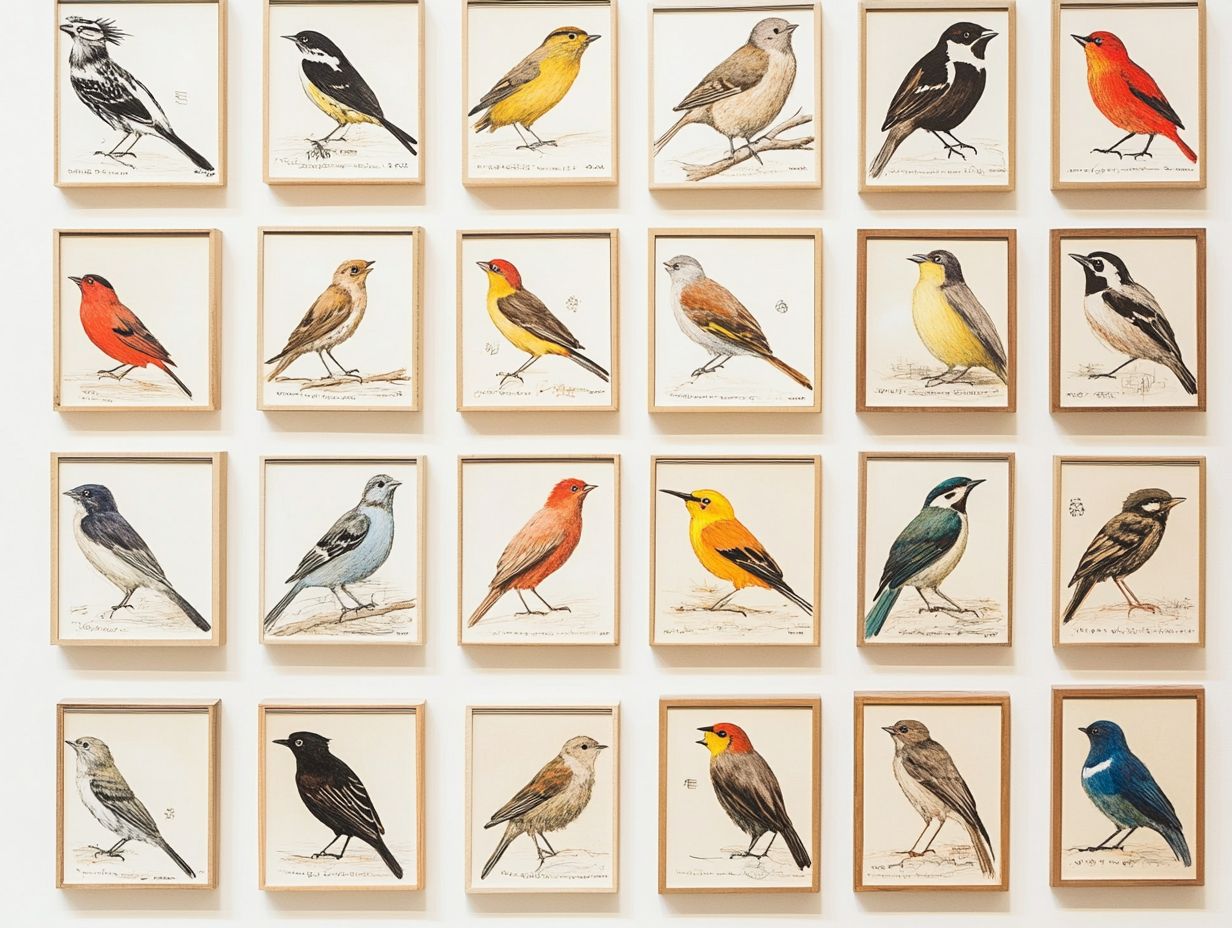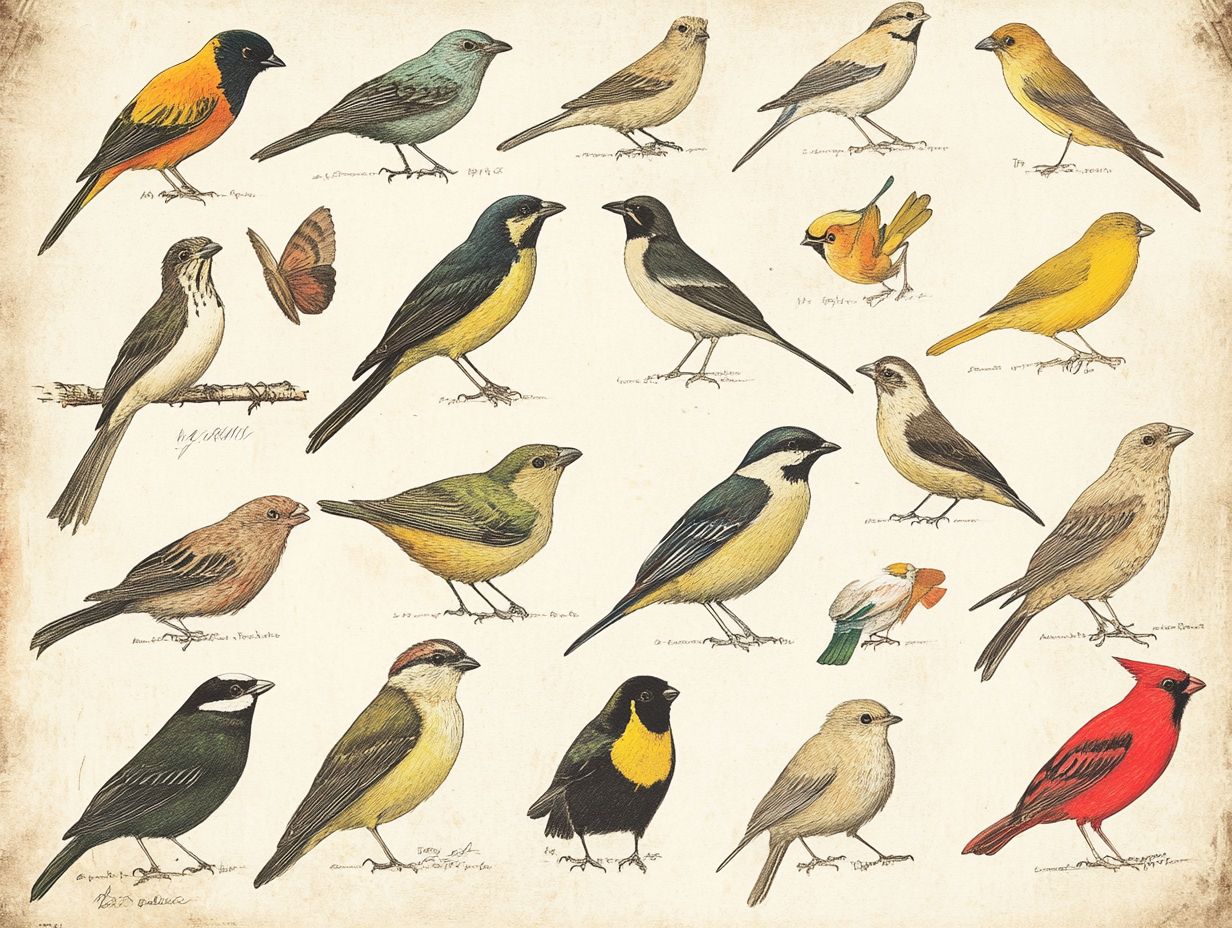The Evolution of Bird Field Guides Over Time
Bird field guides have always been indispensable resources for birdwatchers and nature enthusiasts. They offer valuable insights into various avian species and their habitats. This article delves into the captivating journey of bird field guides, tracing their origins from simple identification tools to the technologically enhanced versions we see today.
You ll discover their evolution, the debates regarding accuracy and ethics, and what the future may hold for these invaluable resources. Join in as you uncover the pivotal role that bird field guides play in enhancing your understanding of the natural world.
Contents
- Key Takeaways:
- The First Bird Field Guides and Their Legacy
- Changes in Bird Field Guides over Time
- The Role of Technology in Modern Bird Field Guides
- Controversies Surrounding Bird Field Guides
- The Future of Bird Field Guides
- Frequently Asked Questions
- How have bird field guides changed over time?
- What are the best practices for responsible birdwatching?
- How can I contribute to bird conservation?
- When was the first bird field guide published?
- What impact did technology have on bird field guides?
- How have bird field guides adapted for bird watchers?
- Are bird field guides still relevant today?
- What can we expect from the future of bird field guides?
Key Takeaways:

- Traditional bird field guides were used primarily for identification and classification. Modern guides have evolved to include behavioral and ecological information.
- The influence of technology has greatly impacted the accessibility and functionality of bird field guides, making them more user-friendly and dynamic.
- Controversies surrounding accuracy and ethical concerns have prompted improvements in bird field guides. These include incorporating more inclusive and responsible language and representation.
What are Bird Field Guides?
Bird field guides are important tools for birdwatchers and nature lovers. They offer a wealth of detailed information about various bird species, their characteristics, and habitats. These guides prove crucial in the field, helping both novice and seasoned birdwatchers identify species like the Ruby-throated Hummingbird or the American Robin with confidence.
Often enriched with illustrations and sonograms, they become essential tools for anyone passionate about birdwatching. This is especially true in diverse regions like Mexico, where unique species such as the Cinnamon Hummingbird and Broad-billed Hummingbird thrive.
Historically, these guides have transformed from simple species lists into comprehensive volumes that beautifully blend art, science, and field research. As techniques in bird identification have advanced, so have the methodologies within these guides, including the most comprehensive bird field guides available, reflecting current conservation efforts and habitat awareness.
By immersing yourself in these resources, you not only enhance your birdwatching experiences but also contribute to citizen science initiatives that monitor avian populations. Dive into these field guides to discover the amazing diversity of our feathered friends and why it s urgent we protect them!
The First Bird Field Guides and Their Legacy
The creation of the first bird field guides represents a significant milestone in ornithology. These guides enable you to identify and appreciate avian species in their natural habitats with ease, highlighting the role of illustrations in bird field guides.
Pioneers like Emmet Reid Blake and Irby Davis played pivotal roles in developing these early guides. They were essential for fieldwork in regions such as Mexico and the Islas Tres Mar as, where unique species flourished.
These guides acted as valuable reference materials. They enriched your understanding of bird behavior, migration patterns, and habitat preferences, deepening your connection to the avian world.
Early Examples and Purposes
Early bird guides are not just identification tools; they re your gateway to fostering a deep appreciation for ornithology. Whether you re a novice enthusiast or a seasoned professional, these groundbreaking publications serve as critical references.
They detail various bird species while offering valuable insights into their behaviors and habitats. These guides truly enrich your birdwatching experience. Take, for instance, the remarkable Northern Cardinal or the regal Bald Eagle. These guides highlight their unique characteristics with stunning visuals and captivating narratives.
As their popularity soared, these guides profoundly shaped birdwatching culture, giving the power to a generation to embark on field trips armed with knowledge.
They also play a crucial role in conservation efforts, raising awareness about declining species and habitats. They inspire dedicated individuals like you to take action in protecting avian diversity, making a meaningful impact on the natural world.
Changes in Bird Field Guides over Time

The evolution of bird field guides over time mirrors the remarkable advancements in bird study and technology. This transformation shapes the future of bird field guides in the digital age, changing how you engage with your passion for birdwatching.
From the classic printed guides to cutting-edge photographic manuals and sophisticated digital applications, these changes have greatly enhanced the accuracy of field identification. Additionally, understanding bird behavior with field guides makes resources more accessible to bird enthusiasts.
As birding has surged in popularity, particularly in areas like Mexico with its rich species diversity, these guides have evolved to cater to both casual birdwatchers and dedicated ornithologists. This ensures that everyone can enjoy their experience to the fullest.
Evolution of Format and Content
The format and content of bird field guides have undergone a remarkable transformation. They’ve evolved from simple illustrations into detailed guides that now feature sound recordings of bird calls and digital formats. For those interested in birdwatching, understanding the layout of bird field guides reflects a deeper understanding of bird behavior and habitat preferences.
In biodiverse areas like San Blas, Nayarit, tailored guides highlight local species such as the Ruby-throated hummingbird. With cutting-edge technology, these guides now captivate both amateurs and pros.
These innovations elevate the educational value of the guides and create a more immersive experience for you as a user. For example, the inclusion of sound recordings helps you become acquainted with unique vocalizations, making it easier to identify species by ear.
The rise of digital formats brings interactive features like location-based identification and real-time updates on bird populations. Dive deep into the avian world like never before!
The Role of Technology in Modern Bird Field Guides
Technology has transformed the landscape of modern bird field guides. You now have unparalleled access to a wealth of information through digital apps and online resources.
Platforms created by esteemed organizations like National Geographic make it effortless for you to connect with birding communities and tap into real-time data on various species, their habitats, and foraging behaviors.
This technology simplifies the process of field identification and enriches your overall birdwatching experience. This is especially true in vibrant regions like Mexico, where distinctive species thrive, including the Cinnamon Hummingbird and Broad-billed Hummingbird.
Advancements and Impact on Birding
Recent advancements in bird field guides, especially those with interactive features and binocular app integrations, have revolutionized the birding community. These tools assist in field identification and enrich your observational experience.
In diverse regions like Islas Tres Mar as, modern guides offer essential insights that enhance traditional birdwatching techniques. They often highlight the unique adaptations of local populations.
The introduction of audio recognition technology has transformed how you identify species, giving you the power to match songs and calls with visual sightings seamlessly. With real-time data sharing capabilities, you can contribute to citizen science initiatives, enriching the collective understanding of avian populations.
Features like customizable checklists and locality-specific tips enable you to tailor your birding adventures to your unique interests. These advancements streamline the identification process and cultivate a more immersive and educational experience.
Join the birding revolution today download the latest apps and start your adventure!
Controversies Surrounding Bird Field Guides

Controversies surrounding bird field guides focus on accuracy and the ethics of birdwatching practices. Organizations like the American Bird Conservancy raise important questions about how novice birdwatchers might inadvertently affect vulnerable species.
As birdwatching gains popularity, particularly in biodiverse regions such as Mexico, these discussions become increasingly critical. They remind us of the need to safeguard natural habitats and protect our avian friends.
Accuracy and Ethical Concerns
Accuracy in bird field guides is essential for effective identification. However, it’s important to consider the ethical implications when inexperienced birdwatchers disturb delicate ecosystems. Finding a balance between responsible birdwatching and the thirst for knowledge requires careful effort and awareness of potential consequences.
This awareness is especially vital in biodiversity-rich areas like San Blas, where protecting species such as the Ruby-throated hummingbird should be a top priority. You are encouraged to deepen your understanding of local species’ specific habitats and behaviors to minimize disturbances.
Maintaining a respectful distance, using binoculars instead of approaching nests, and avoiding playback of bird calls are critical practices to help preserve the natural behaviors of these avian residents.
Engaging in local conservation initiatives and contributing to citizen science projects where regular people help collect data for science can significantly enhance your knowledge while supporting ecosystem protection. By adopting a mindful approach, you can play a vital role in preserving avian diversity while enjoying the enriching experience of birdwatching.
The Future of Bird Field Guides
Exciting innovations are reshaping the future of bird field guides, seamlessly blending digital advancements with a focus on conservation.
As technology evolves, you can expect guides that offer real-time data, enhanced interactivity, and robust integration with initiatives aimed at safeguarding habitats and species. This is crucial as areas like Mexico face ecological challenges threatening their avian diversity, underscoring the importance of responsible birdwatching and effective conservation strategies.
Predicted Trends and Developments
Predicted trends in bird field guides indicate a shift toward dynamic, user-friendly digital formats that emphasize field identification while prioritizing conservation efforts. For more insights, check out understanding bird identification with field guides. These advancements aim to engage a new generation of birdwatchers, promoting sustainable practices and nurturing a deeper appreciation for avian life.
With organizations like National Geographic and the American Bird Conservancy leading these initiatives, the future of birding looks bright for diverse ecosystems, such as those found in Mexico. Imagine the potential of interactive features like real-time location tracking, augmented reality overlays, and social sharing tools; these innovations are set to revolutionize your connection with nature.
These guides will increasingly utilize data analytics the process of examining data sets to draw conclusions to provide insights into migratory patterns and population health. This makes it easier for you to contribute to citizen science projects and conservation efforts.
By embracing mobile applications, you can track your birdwatching observations while actively supporting initiatives that protect endangered species. Join us in the global preservation of biodiversity!
Frequently Asked Questions

How have bird field guides changed over time?
Bird field guides have evolved significantly over time, transforming from simple drawings and descriptions to comprehensive guides that include photographs, range maps, and behavior information. This evolution highlights the impact of technology on bird field guides.
What are the best practices for responsible birdwatching?
Best practices include keeping a respectful distance from birds, minimizing noise, and avoiding disruption of their habitats.
How can I contribute to bird conservation?
You can participate in local conservation initiatives, join citizen science projects, and educate others about the importance of protecting bird species.
When was the first bird field guide published?
The first bird field guide, titled “Birds Through an Opera Glass,” was published in 1902 by Florence Merriam Bailey. It featured hand-drawn illustrations and descriptions of 70 bird species.
What impact did technology have on bird field guides?
Technology has transformed bird field guides significantly. Today’s guides include high-quality images and detailed maps, reflecting the evolution of birding technology thanks to advances in photography and printing.
How have bird field guides adapted for bird watchers?
Bird field guides are now more informative, covering bird behavior, habitat, and conservation status. They are also available in various formats, including digital guides and smartphone apps.
Are bird field guides still relevant today?
Absolutely! While the internet offers quick facts, field guides provide a comprehensive and portable resource for bird watchers in the field.
What can we expect from the future of bird field guides?
Future bird field guides may feature interactive elements like augmented reality, which enhances the viewing experience by overlaying digital information on the real world. We will likely see a greater emphasis on conservation efforts and the inclusion of lesser-known bird species.






